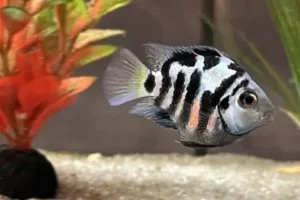Your cart is currently empty!

Polar Blue Parrot Cichlids Care, Tank Mates & Breeding Guide
I
One type of hybrid fish that has become quite popular in the aquarium hobby is the Polar Blue Parrot Cichlid. one of the easiest saltwater fish in the aquascape because of its hardy pelagic nature. If you’re thinking of adding one of these fish to your aquarium, the following guide outlines their care, breeding and ideal tank conditions.
Polar Blue Parrot Cichlids — A Guide
As a hybrid species, Polar Blue Parrot Cichids are produced when a Blood Parrot Cichlid is crossed with a Convict Cichlid. They catch the small, parrot-like physique of their parent, the Blood Parrot, as well as the bright blue color of the Convict Cichlid, creating a great fish for your tank to watch. As hybrids, these fish may be some of the most cichlid-like in behavior, including territoriality and active swimming.
Tank Setup & Water Conditions
A well-balanced and stable aquatic environment is critical for the success of your Polar Blue Parrot Cichlid.
Tank Size
In terms of tank size, a minimum of 30 gallons is recommended for a single Polar Blue Parrot Cichlid.
If you plan to keep several cichlids or tank mates, a 50 to 75-gallon tank will help mitigate territorial aggression.
Water Parameters
Temperature: 75°F to 82°F
pH Levels: 6.5 to 7.5
Water Hardness: Soft to medium hard (5-15 dGH)
It is important to include a sturdy filter in order to keep the water quality high, as this species of fish create moderate amounts of waste.
These factors make sand/ fine gravel the best substrate choice, much similar to their environment.
Tank Decorations
Add rocks, caves, and driftwood for hiding places: these fish like a little because of shelter.
Do not add sharp decorations that can tear their delicate fins.
Artificial or live plants can also be used, but be sure they are planted in such a way that they will not uproot.
Feeding Your Polar Blue Parrot Cichlid
Feeding your Polar Blue Parrot Cichlid a good quality diet is important for keeping them healthy and helping their color pop.
Dietary Requirements
High-quality pellets: Look for cichlid-specific pellets that provide a balanced nutrient mix.
Live and frozen foods: Bloodworms, brine shrimp and daphnia can help supply protein.
Vegetables: Occasional servings of blanched spinach, peas and zucchini round out their diet.
Dont over feed: Feed them in small portions, around 2-3 times a day and immediately remove any unconsumed food from the tank.
Behavior & Tank Mates
Polar Blue Parrot Cichlid Temperament Polars are semi-aggressive, but they can also show territorial behaviors, particularly during breeding. Adding the right type of fish as tank mates will help keep the peace in the aquarium.
Compatible Tank Mates
Other cichlids (e.g. Firemouth Cichlids or Blue Acara)
Corydoras Catfish [Bottom Dwellers]
Silver Dollars, peaceful and fast-moving fish
Steer clear of dwarf, docile fish that will get bullied
Territorial Behavior
They become aggressive and territorial during breeding.
Provide plenty of hiding spots, (and swimming space) to avoid conflicts.
Polar Blue Parrot Cichlid Breeding
Because they are hybrids, breeding cannot be easy, but it can be done under certain circumstances.
Setting Up a Breeding Tank
An ideal setup is a 20-30 gallon breeding tank.
Big flat rock or cave: They like to spawn in shelter.
Good water quality is paramount, and slightly elevated temperatures (80°F) will induce them to breed.
Breeding Behavior
The male and female share a courtship dance, which involves locking lips and displaying their fins.
The female deposits her eggs on a prepped host or substrate, which the male fertilizes.
Most hybrids have low parental instincts and do not protect the eggs.
Caring for the Fry
Eggs hatch after 3–5 days, and fry become free swimming in approximately one week.
Feed newly hatched brine shrimp or powdered flake foods.
Avoid to lose these fry to the adult fish by separation.
Common Health Conditions & Solutions
As with all fish, Polar Blue Parrot Cichlids are susceptible to common aquarium diseases. Drinking clean water and having a proper diet prevents getting sick.
Potential Health Problems
IchHandtery (White Spot Disease) – Treat with temperature adjustments and medication.
Swim Bladder Disease – Do not overfeed and give high-fiber foods.
Bacterial Infections – Maintain a clean tank and prevent stress.
Except for the Blue Parrots: Interesting Facts & Things
The Polar Blue Parrot Cichlid is also to be distinguished from the Blue-Headed Parrot a bird species found throughout parts of south america, which is recognized by the striking blue head and bright green body.
The other relevant term associated with “blue parrot” is Blue Parrot Beach Cam, which encompasses several beach streaming cams named after the exotic bird species.
Final Thoughts
Polar Blue Parrot Cichid is a Wonderful and interesting fish for your aquarium However, with adequate care, ideal nutrition, and the right set up in a tank, they can flourish and show off their beautiful blue tones. From novice to experienced aquarist these fish make for a rewarding and an enjoyable fish-keeping experience.
With that, if you are planning to add a Polar Blue Parrot Cichlid in your tank, make sure to give them suitable environment and take care of their health to keep them happy and healthy for many years.

Leave a Reply